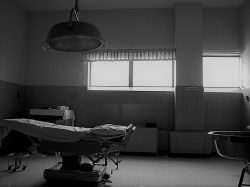When you write about hormonal birth control, it becomes a sort of self-perpetuating torture. Women who have been injured frequently reach out to share their stories with you, and it never stops being painful. Each story pierces your soul as they recount their devastating experiences related to The Pill.
How could your heart not ache as you speak with a young woman who used to be healthy but now awakens to pain every day? Some deal with the fear of knowing their liver adenoma could rupture at any moment, and they would die instantly. Others wake up knowing the chronic pain of an autoimmune disease will be with them until their final days.
Their lives look very different than they imagined as little girls. Even the act of telling their story brings new pain to the surface, but there is also a redemptive quality in sharing their story. These women are warriors. They continue to battle against the permanent damage done to their bodies. And, despite the pain it causes, they share their stories because they want to warn other young women about the real dangers of hormonal birth control.
Shattered Families
Perhaps the only thing more devastating than their stories are those of families whose sisters, wives, and daughters lost their lives to birth control. Imagine losing your young daughter to blood clots. You never even entertained the idea that she could die before you, but suddenly she’s gone without warning.
THAT is unspeakable pain.
Thankfully, there are families who fight through the pain and muster up the strength to talk about it. Once again, they do it out of the very selfless desire to warn others. I have been blessed to meet many of these families on my birth control journey. Some of them have shared their stories publicly. These stories embody the reason women need to be warned about the real risks. I encourage you to seek out their stories and read them.
Here are a few of them:
- Anthony, the heartbroken father who reached out to me after reading one of my articles on Hormones Matter. His daughter died the day that article published.
- Laura, the mother who hesitantly let her 16-year-old start birth control after the doctor assured her it was the safest, lowest dose possible. She died in a few short weeks. Overcome with guilt, Laura took her own life on Thanksgiving Day a couple of years later.
- Dru, the sweet mother who, since losing her daughter, passionately works to educate women not only about the risks of hormonal birth control but also about blood clot awareness.
- Or, Joe, the father who relentlessly fights to shine a light on injury and mortality data that the drug companies try to downplay.
Next Level Shock
By reading and hearing these stories, we can only grasp a small taste of how agonizing it must be to lose a loved one who was so young and vibrant. For me, the stories feed my passion to help spread the word about the dangers that are not being fully presented. The individual twists and unique aspects of each story, each family, each woman stir my motivation in different ways.
I would like to share another story I recently came across that left me feeling gut-punched unlike any other.
A Dark Day in the Black House
Raymond Black knew that his wife, Betty Jo, had not been feeling well as he traveled back to Indiana from a business trip. Still, he was surprised to find his mother-in-law taking care of their five young daughters when he arrived home from the airport. He had expected that the shot the doctor gave Betty Jo would be taking effect by now and her flu-like symptoms would be getting better. Instead, his wife was feeling even weaker.
By the next morning, the situation had declined to the point that Raymond drove her to the Emergency Room at St. Joseph’s Hospital. The doctor reviewed her tests and chest x-ray before assuring the couple that it was nothing more than an “influenza type of bronchitis.” He sent them home with an antibiotic prescription and instructions to rest.
For the remainder of the day, Betty Jo writhed back and forth in bed. Raymond felt hopeless as she described a burning feeling in her chest and back. Then, around 8:40 pm, she grabbed her chest and wheezed, “I’m having trouble breathing – get an ambulance!”
Her ER doctor from earlier that day, Dr. Dolezal, said they would have a “Code Blue” team awaiting her arrival. She coughed and convulsed the entire trip. Riding in the ambulance, Raymond held the oxygen mask as the EMTs had instructed, but still felt helpless as he watched Betty Jo pass out.
Once at the hospital, doctors and nurses worked feverishly. Her brain wasn’t getting enough oxygen. An internist pushed a tube down her windpipe, another counted out loud as he compressed on her breastbone. This exhausting scene continued for what must have seemed like an eternity until Dr. Dolezal eventually pulled Raymond to a quieter area of the ER at around 10:55 pm to tell him his wife wasn’t going to make it.
Stunned and Confused
Raymond was stunned and confused. He was quite sure the mild bug that his children had passed around could not have killed his healthy 29-year-old wife. In the eight years they had been married, Betty Jo had only been treated by a doctor for two sore throats and irregular periods.
For the latter, her doctor suggested hormonal birth control to help regulate her cycle. Being Roman Catholic, Betty Jo felt uneasy but sought permission from her priest before taking the synthetic steroids as a medical treatment.
She was the very definition of a healthy young woman, but something changed – something that literally decimated her health within just a few short days.
The weight of the world suddenly rested on Raymond’s shoulders. He was still the supervising engineer at a hectic workplace overseeing the biggest project in his company’s history. His five daughters were all below the age of seven, and were mourning the loss of a mother they loved dearly. Yet, while trying to maintain an impossible balance between work and home amongst all this turmoil, his engineering mind could not stop trying to piece together what could have killed his beautiful bride.
When the autopsy report came back, the first jigsaw piece fell into place and the mystery began to unravel. The report said Betty Jo died from a “large, solid blood clot that had formed in her right ovarian vein and passed through the heart before lodging – and closing – the pulmonary artery leading to the lungs.”
Unraveling the Mystery
Recognizing that The Pill’s primary function is to prevent a fertilized egg from leaving the ovaries, Raymond felt like he had just made eye contact with the primary suspect.
You might think it would be a pretty easy process to connect the dots at this point. There is no shortage of data supporting the link between hormonal birth control and deadly blood clots. But, there is another important fact that added to the difficulty of Raymond’s situation. This entire episode happened in 1965.
At that time, all the voices of authority, from the FDA to the media to local doctors were saying The Pill was completely safe. However, it didn’t take long for Raymond to find a doctor in South Bend who, after reviewing the autopsy report, admitted he personally knew of two patient deaths and another patient who almost died that he attributed to The Pill. However, he feared that he could be sued for contributing to the death of those patients, and said that he would not be able to testify for any pending legal proceedings.
Raymond persisted, combing through newsletters and letters to doctors from the drug companies. He found a newsletter from Searle that revealed: “As of this date in the United States there have been reported to us 272 cases of thromboembolic disease in Enovid users. In these reports are 31 fatalities.”
The newsletter detailing their knowledge of this complication had been printed two years before Betty Jo started birth control.
Pause and Reflect
This hurts.
This really hurts.
For two years, they knew about the clotting issues, but Betty Jo didn’t. In fact, all Betty Jo did was become another statistic. The general public continued believing The Pill was completely safe. It would be another three years after her death before the British Medical Journal would begin to blow the lid off their cover with the Inman-Vessey study.
That study focused on another blood clot-related outcome. It demonstrated that young women taking The Pill experienced a 7.5-fold increased risk of death from a stroke. Who knows how many others died when their clotting blood led to a pulmonary embolism as had Betty Jo’s.
Too many… whatever the number.
Think how different things could have been if the drug companies or their regulators had taken appropriate action when this news came to light. Think how many parents, husbands, and children in the 1970’s alone could have been saved from the devastating aftermath of losing a young woman they loved. Now, add on the lost lives and grieving relatives of each subsequent decade. My God, the carnage mounts exponentially.
That’s 60 years of dead women – 60 years of regulatory inaction – nearly 60 years where something could have been done that might have saved the women whose families’ stories I shared above.
That’s why this story knocked the wind out of me.
Evidence Mounts
But, it took another newsletter to really trigger Raymond’s rage. He could not believe it when he read that researchers had identified that women with a tilted uterus might be “predisposed to thrombosis” when they used hormonal birth control.
Betty Jo had a tilted uterus. Combined with her misgivings about The Pill, this little bit of information could have been enough to convince her not to take it, and could have ultimately saved her life. Instead, the only “warning” she encountered in the information pamphlets from the manufacturer said that some women experienced temporary nausea and breast tenderness.
Raymond was convinced the drug companies were downplaying the risks. He consulted a couple of attorneys who warned him that his chances of winning a lawsuit were highly improbable. They reasoned that the drug companies would have an endless supply of physicians and researchers with financial ties who would be willing to testify on behalf of The Pill, while he would be able to offer little more than hearsay as evidence.
Unfazed, Raymond filed a suit for $750,000 in damages against G.D. Searle & Company on the second anniversary of Betty Jo’s death. He told the press, “I don’t care if I win the case or not. I want this underreporting out in the open.”
Is There a Doctor in the House
Contrary to the previous attorneys’ opinions, Raymond was able to locate numerous doctors eager to testify about their concerns surrounding hormonal birth control. It turned out that not every doctor operated purely on financial motivation. The trial garnered a lot of attention because it marked the first time the division in the medical community came to light, and it was happening in such a public forum.
One of the most adamant physicians to testify on behalf of the Black family was Dr. John F. Hillabrand, Director of Obstetrics and Gynecology at St. Vincent’s Hospital in Toledo. After Dr. Hillabrand emphatically stated that he believed The Pill had been the cause of Betty Jo’s death, the attorney for Searle, James Pankow, tried to undermine his credibility by suggesting Dr. Hillabrand hadn’t published many articles in leading medical journals.
Dr. Hillabrand shot back that he had never worked for a medical school that sought grants and published papers just to stay in business. Rather, he stated, “I have delivered eight thousand babies and not lost a mother, and I’d kind of like to keep it that way.”
He went on to describe the changes he had personally witnessed as a surgeon since women started taking The Pill, specifically the effects from the blood’s artificially slowed circulation and enlarged “veins in the genital organs and chest so that the blood congeals, much the same way that water freezes in a leisurely flowing stream.” When Mr. Pankow called into question the veracity of this claim, Dr. Hillabrand retorted, “…had you been in the operating room with me on any number of occasions when you tried to perform major surgery – either vaginal or abdominal – on some of these people, you will have the most exciting time trying to control bleeding because of the dilation [expansion] of these vessels.” He went on to explain that he had actually started the practice of having women stop taking The Pill to “simmer down” before performing such procedures.
In one final attempt to mitigate Dr. Hillabrand’s contempt for The Pill, Mr. Pankow pivoted, “Obviously, you will admit that there are competent gynecologists and obstetricians who prescribe The Pill for contraceptive purposes.”
Dr. Hillabrand replied, “No, I will say they do it, but to the extent they do it, in my opinion, their competence should be questioned.”
The Verdict
Anyone who had ever had any issues with The Pill or knew of anyone who had was removed from the jury pool during the selection process along with anyone who professed any preconceived notions about birth control. So, when it came time for deliberation, Leroy Skodinski, the lumber salesman who was ultimately elected to be the jury foreman, and the other jurors, who came into the trial knowing nothing about birth control, struggled with interpreting all the competing medical arguments they had heard.
When they discussed whether Searle had been negligent, the conversation kept coming back to the fact that the company was now warning doctors about side effects, but they wondered how many doctors were actually telling their patients. Mr. Skodinski pointed out that when Betty Jo died four years earlier no one was being warned.
Ultimately, the jurors agreed that they could not say that The Pill had killed her “beyond the shadow of a doubt,” nor could they hold the drug company responsible for the stronger evidence tying their drug to blood clots that came out after Betty Jo’s death. Still, they felt uneasy about the company’s history of downplaying the risks to doctors and the women taking the drug. So, they agreed to a compromise.
Back in the courtroom, Mr. Skodinski read the verdict finding for the defendant on all charges, but everyone was shocked when he continued reading, “Further, it is the recommendation of this jury that, effective immediately, G.D. Searle and Company, in instruction literature both to doctors and patients, advise the dangers of the possibility of phlebitis, thrombotic, and embolic phenomena.”
The judge sternly informed the jury that this was not how the system works, and their stipulation could not be enforced. The court records simply show that G.D. Searle was exonerated, period. In reality, the jury who exonerated them walked away knowing the system had failed the victims.
No One Answered the Wake-Up Call
In so many ways, this is a fitting ending to this moment in time. Betty Jo’s death and her husband’s tenacious fight woke some people up. Their story may have inspired a few more advocates to jump on board. Even the media started paying attention as this was the first time anyone questioned the mighty Pill. You can find a detailed account of Raymond and Betty Jo Black’s story in Good Housekeeping, January 1970.
But, in the end, as so often happens, the drug company walked away virtually unscathed. Soon, things returned to normal and most people stopped paying attention again. For starters, whatever happened to the whole tilted uterus thing? I have been unable to find any continuing research on this important detail.
I still have hope. Each time the drug companies are challenged like this, more people wake up to their game. Raymond may have lost the case, but he did raise eyebrows simply by bringing the underreporting out into the open. He succeeded at his stated goal.
I am all about celebrating the small victories, but at the same time, I can’t help but wonder how much progress we have really made in educating women about blood clots from hormonal birth control – not to mention any of the other truly dangerous side effects. Are we any further along than when Betty Jo died 60 years ago?
Postscriptum
Not long after I finished the first draft of this article, a woman in the Facebook group I started to encourage discussions about birth control posted this query:
Got a question about leg swelling that won’t go down but literally gets bigger, severe dizziness, blurry vision that’s getting worse, back pain on lower right, severe anxiety and panic attacks… I have the Nexplanon and wondering if it’s related.
We still have a lot of work to do, but the more we can encourage open communication about birth control the better chance we have of saving the life of the next woman.

The FDA approved The Pill despite it not being proven safe. Today, it has been linked to everything from blood clots and cancer to lupus and Crohn’s disease — and still has not been proven safe.
This book explores the medical and historical disconnects that brought us to this point.
Last updated on October 21, 2023 at 9:38 pm – Image source: Amazon Affiliate Program. All statements without guarantee.
We Need Your Help
More people than ever are reading Hormones Matter, a testament to the need for independent voices in health and medicine. We are not funded and accept limited advertising. Unlike many health sites, we don’t force you to purchase a subscription. We believe health information should be open to all. If you read Hormones Matter, like it, please help support it. Contribute now.
Yes, I would like to support Hormones Matter.
Photo by Alexander Grey on Unsplash.















